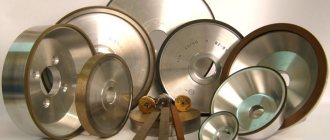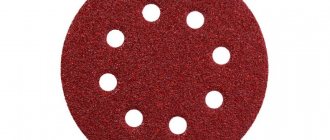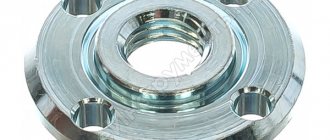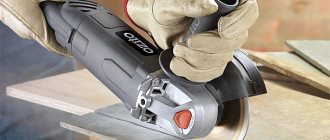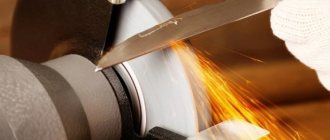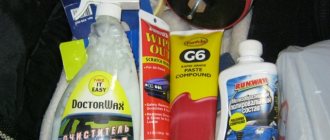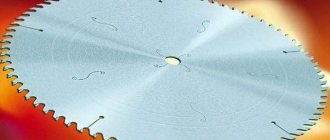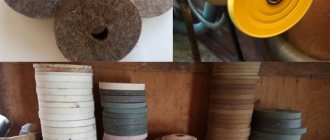Typical disk sizes for angle grinders
All interchangeable wheels have standardized sizes, so for any model of grinder you can choose a suitable size disk, even if it is “non-original” (from another company). The table below shows the typical dimensions of cutting discs in terms of thickness, diameter of the circle and seat:
| Circle diameter, mm | Thickness, mm | Mounting socket, mm |
| 115 | 1,0; 1,6; 2,0; 2,5; 3,0; 3,2 | 22,00; 22,23 |
| 125 | 0,8; 1,0; 1,25; 1,6; 2,0; 2,5; 3,0; 3,2 | 13,20; 22,23 |
| 150 | 0,8; 1,0; 1,25; 1,6; 2,0; 2,5; 3,0; 3,2 | 13,20; 22,23 |
| 180 | 1,0; 1,25; 1,6; 2,0; 2,5; 3,0; 3,2; 4,0 | 22,23; 32,00 |
| 230 | 1,6; 2,0; 2,5; 3,0; 3,2; 4,0 | 22,23; 32,00 |
The larger the diameter of the circle and its thickness, the thicker the products it can cut. Please note that the diameter of the disc should not exceed the permissible size for a particular grinder model. Thus, a 230 mm disc cannot be placed on an angle grinder with a maximum allowable wheel size of 125 mm. Such actions will force you to remove the protection, which is a violation of safety regulations, and will lead to an increase in the linear speed of the cutting edge, which is why the disk can simply fly apart during operation and injure the operator.
The diameter of the seat in most grinders is 22.23 mm, 13.20 mm is less common, and the diameter of 32.00 is relevant only for large disks. Pay attention also to the linear speed of rotation of the disk. For example, if the disc’s marking indicates a speed of 13,000 rpm, this means that your grinder must also produce such revolutions in order to work with it.
You can understand what material the nozzle can work with and what its typical dimensions are by looking at its markings on the front side. If you came to the store and picked up the disc, you can see the following:
We would like to note that sometimes the buyer may encounter non-standard nozzle sizes, and this may apply to both diameter and thickness. This often happens when purchasing “no-name” disks of unknown manufacture. We still recommend buying branded discs, since unknown ones are erased faster, and in the end you have to pay more.
Hardness and other parameters
Hardness is the ability of the binder to keep the grains from being pulled out, which affects the ability to self-sharpen. There are a total of 8 hardness groups according to the table below.
The next parameter is the structure of the wheel, which implies the percentage of abrasive per unit volume. The dense structure is designated by numbers from 1 to 4, medium 5 – 7, open 8 – 10 and highly porous 11 and 12.
Next comes the link designation. Ceramic is designated by the letter V or K according to the old GOST, bakelite - V (B) and vulcanite R (B). Bakelite bond with hardener is designated BF (BU), with graphite filling B4 (B4). Accuracy class AA, A and B. The most accurate is AA, wheels of this class are used in automatic lines. And the last value is the class of tool mass imbalance. Indicated by numbers from 1 to 4. This parameter does not affect the balancing of the tool assembled with flanges.
Cutting discs
Cutting discs are most often used when working with an angle grinder. The following nozzles are distinguished by purpose:
- For metal. Such cutting wheels are made from electrocorundum or crystalline corundum. In this case, a bakelite bond is often used inside the product. Depending on the thickness and size, the disc can cut metal profiles, stainless steel, heating pipes, etc. GRAFF GADM 115 10 is one of the representatives of inexpensive metal discs.
- For stone and concrete. Circles for cutting stone and concrete are made of silicon carbide. Please note that the disc is intended for relatively “soft” materials, such as white brick and slate (harder ones will require a diamond wheel).
- For ceramic tiles and concrete. This attachment is designed for cutting paving stones, ceramic tiles, red bricks, cutting strips for gating, etc. The disc itself is made of metal with diamond chips applied to the cutting edge. There are solid all-metal and segmented discs. The first ones are intended for wet cutting (cooling with water), as they become very hot during the process. Segmented ones are convenient for dry cutting, and they are the most popular among diamond blades. Here, for example, is a high-quality, durable segmented disk Makita B-28086 for cutting concrete and stone products.
- For wood . Discs for processing wooden structures are made of tungsten carbide or metal with abrasive coating. The first ones are designed for cutting hard and soft wood, plasterboard, gas silicate and MDF. The second one can also cut metal and even wood with nails (but this needs to be checked experimentally). Bison Professional 36859-125 is just such a representative of the “nail saw”.
- Universal. These attachments can cut almost all types of materials (for wood, it is better to take a direct-use attachment). In particular, they are convenient to use when you have to cut different materials in one working day, and you don’t want to waste time changing the nozzle. Universal models even cut reinforced concrete. However, they are often quite expensive, and sometimes it is more profitable to buy two disks for different types of materials being processed. Of the good universal circles, we can recommend Wolverine 100125, which is suitable for both wet and dry cutting.
Abrasives and grit
The abrasive material is indicated by alphanumeric markings. Thus, electrocorundum is marked with the letter A. White electrocorundum - from 22A to 25A, normal from 12A to 16A, chromium from 32A to 34A. There are also titanium electrocorundum (37A), zirconium (38A) and other varieties. The higher the number, the higher the quality of the material. Silicon carbide is designated by the letter C and is divided into black (from 52C to 55C) and green (62C – 64C).
Diamond wheels are marked as follows:
- AC2 – circle of normal strength.
- AC4 – increased strength.
- AC6 is a high-strength abrasive.
- AC32 is a monocrystalline abrasive.
The grain size determines the cleanliness of the resulting surface. The marking indicates the size (width) of the grain. In accordance with the old GOST 3647-80, this parameter is indicated in units equal to micrometers divided by 10 (10 = 100 microns). Micropowders are marked with the letter M. According to the new GOST R 52381-2005, the grain size is indicated by the letter F and a numerical designation. Moreover, unlike the old standard, the larger the number, the smaller the abrasive grain size.
Roughing
It’s worth mentioning right away that roughing and grinding discs go hand in hand, and in many stores in the “type” parameter of the attachment it may be written: “roughing grinding disc.” In our article we will divide this “couple” into two types. Peelers in this context are an attachment for freeing the structure being processed from the outer layer, for example, from rust. There are the following peeling attachments:
- Cord brushes. Cord brushes are disc or cup-shaped. Disc ones are convenient for cleaning vertical structures, for example, a tubular fence, and cup-shaped ones are used for cleaning horizontal surfaces. So cord brushes are very convenient for cleaning a car body after welding or removing rust. Here is an average-priced brass cord brush STAYER 35125-150:
- Roughing discs. Sanding discs, like cord brushes, can be flat or cup-shaped. They are intended for cleaning welds and preparing metal surfaces for grinding.
Grinding
Grinding wheels are used for polishing concrete, metal and wooden surfaces for painting or priming. Attachments for circles can be made of sandpaper, felt and even felt. In turn, the design of sanding wheels can be petal or flat (put on a wheel).
Each grinding disc has its own grit size. It is selected depending on the work being performed. Below is a table for selecting wheel grit depending on the type of grinding:
| Types of grinding | Recommended grit number |
| Flat | 16 — 36 |
| Round roughing | 24 — 36 |
| Round finishing | 60 — 100 |
| Finishing a multi-blade tool | 170 — 220 |
| Finishing | 180 — 320 |
| Thread grinding | 100 — 280 |
Marking
The main parameters of the circle can be determined by its symbol, which is indicated in the product labeling. The symbol corresponds to GOST R 52781 and indicates:
- circle type;
- material;
- grain;
- geometric parameters (outer and inner diameters, height);
- type of ligament;
- structure and degree of hardness;
- the highest permissible processing speed.
The exception is wheels with individual markings, which have wheels from foreign manufacturers. When purchasing this product, you must study the information in the catalogs and on the packaging.
To summarize: how to choose a disc for an angle grinder?
To properly buy a disc for an angle grinder, you need to:
- Know the maximum size of disks that your angle grinder can handle. You cannot take disks larger than the device allows.
- Know the maximum speed of the grinder . The higher the rotation speed of the angle grinder, the smaller the disk size it can work with.
- Processed material . There are discs for wood, metal and stone. There are universal ones that can cut almost anything.
- Socket size . The size of the wheel seat must correspond to the same parameter in the angle grinder.
- Manufacturer . Do not buy frankly cheap discs or unknown products like hot cakes in the school cafeteria, and the savings will be minimal.
Structure and hardness index
The density of the structure of grinding wheels is indicated by the percentage of the volume of abrasive grains per unit volume of the wheel. The more abrasive, the denser the structure of the grinding wheel will be.
When sharpening a tool, a wheel with a less dense structure is better able to clean the surface of material particles, poses less risk of deformation and cools faster.
Often, specialists use disks of medium hardness, but it all depends on the type of work being performed, the coating being processed and the tool itself.
What are the structure numbers and volumes of abrasive in the grinding wheel:
- dense structures include units of measurement from 1 to 4;
- Average density includes numbers 5-8;
- to open – from 9 to 12;
- a highly porous structure is observed in circles with indicators 13, 14>.
However, do not confuse wheel hardness with abrasive hardness. According to GOST 2424, the hardness of a grinding wheel is distinguished by a capital letter.
According to GOST R 52587-2006, there are the following designations:
- very soft - letters F and G;
- to soft circles – H, I, J;
- medium softness includes markings K, L;
- averages are M, N;
- circles of medium hardness are designated by the letters O, P, Q;
- solids are designated as R and S;
- very hard – T, U;
- Extremely hard ones include V, W, X, Y, Z.
What grinding wheel hardness should I choose? This depends on many parameters - the characteristics of the material or surface being processed, physical properties, and, of course, the power of the grinding machine. If you need to maintain the exact shape of the material being processed, you should purchase a wheel with a high degree of hardness. Soft ones are used to prevent cracks and burns, also when grinding without additional liquid-lubricant cooling of the surface.
For example, let's take the same 25A grinding wheel, which has a hardness class of K and a structure of 7. This means that this disc is medium-soft and has a medium abrasive structure.
